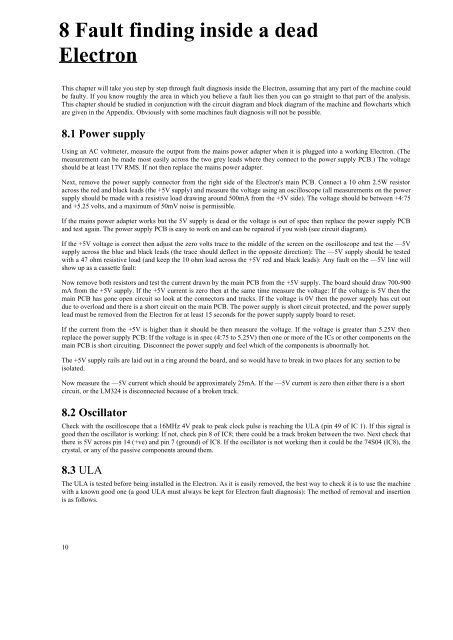Create successful ePaper yourself
Turn your PDF publications into a flip-book with our unique Google optimized e-Paper software.
8 Fault finding inside a dead<br />
<strong>Electron</strong><br />
This chapter will take you step by step through fault diagnosis inside the <strong>Electron</strong>, assuming that any part of the machine could<br />
be faulty. If you know roughly the area in which you believe a fault lies then you can go straight to that part of the analysis.<br />
This chapter should be studied in conjunction with the circuit diagram and block diagram of the machine and flowcharts which<br />
are given in the Appendix. Obviously with some machines fault diagnosis will not be possible.<br />
8.1 Power supply<br />
Using an AC voltmeter, measure the output from the mains power adapter when it is plugged into a working <strong>Electron</strong>. (The<br />
measurement can be made most easily across the two grey leads where they connect to the power supply PCB.) The voltage<br />
should be at least 17V RMS. If not then replace the mains power adapter.<br />
Next, remove the power supply connector from the right side of the <strong>Electron</strong>'s main PCB. Connect a 10 ohm 2.5W resistor<br />
across the red and black leads (the +5V supply) and measure the voltage using an oscilloscope (all measurements on the power<br />
supply should be made with a resistive load drawing around 500mA from the +5V side). The voltage should be between +4:75<br />
and +5.25 volts, and a maximum of 50mV noise is permissible.<br />
If the mains power adapter works but the 5V supply is dead or the voltage is out of spec then replace the power supply PCB<br />
and test again. The power supply PCB is easy to work on and can be repaired if you wish (see circuit diagram).<br />
If the +5V voltage is correct then adjust the zero volts trace to the middle of the screen on the oscilloscope and test the —5V<br />
supply across the blue and black leads (the trace should deflect in the opposite direction): The —5V supply should be tested<br />
with a 47 ohm resistive load (and keep the 10 ohm load across the +5V red and black leads): Any fault on the —5V line will<br />
show up as a cassette fault:<br />
Now remove both resistors and test the current drawn by the main PCB from the +5V supply. The board should draw 700-900<br />
mA from the +5V supply. If the +5V current is zero then at the same time measure the voltage: If the voltage is 5V then the<br />
main PCB has gone open circuit so look at the connectors and tracks. If the voltage is 0V then the power supply has cut out<br />
due to overload and there is a short circuit on the main PCB. The power supply is short circuit protected, and the power supply<br />
lead must be removed from the <strong>Electron</strong> for at least 15 seconds for the power supply supply board to reset.<br />
If the current from the +5V is higher than it should be then measure the voltage. If the voltage is greater than 5.25V then<br />
replace the power supply PCB: If the voltage is in spec (4:75 to 5.25V) then one or more of the ICs or other components on the<br />
main PCB is short circuiting. Disconnect the power supply and feel which of the components is abnormally hot.<br />
The +5V supply rails are laid out in a ring around the board, and so would have to break in two places for any section to be<br />
isolated.<br />
Now measure the —5V current which should be approximately 25mA. If the —5V current is zero then either there is a short<br />
circuit, or the LM324 is disconnected because of a broken track.<br />
8.2 Oscillator<br />
Check with the oscilloscope that a 16MHz 4V peak to peak clock pulse is reaching the ULA (pin 49 of IC 1). If this signal is<br />
good then the oscillator is working: If not, check pin 8 of IC8; there could be a track broken between the two. Next check that<br />
there is 5V across pin 14 (+ve) and pin 7 (ground) of IC8. If the oscillator is not working then it could be the 74S04 (IC8), the<br />
crystal, or any of the passive components around them.<br />
8.3 ULA<br />
The ULA is tested before being installed in the <strong>Electron</strong>. As it is easily removed, the best way to check it is to use the machine<br />
with a known good one (a good ULA must always be kept for <strong>Electron</strong> fault diagnosis): The method of removal and insertion<br />
is as follows.<br />
10

















